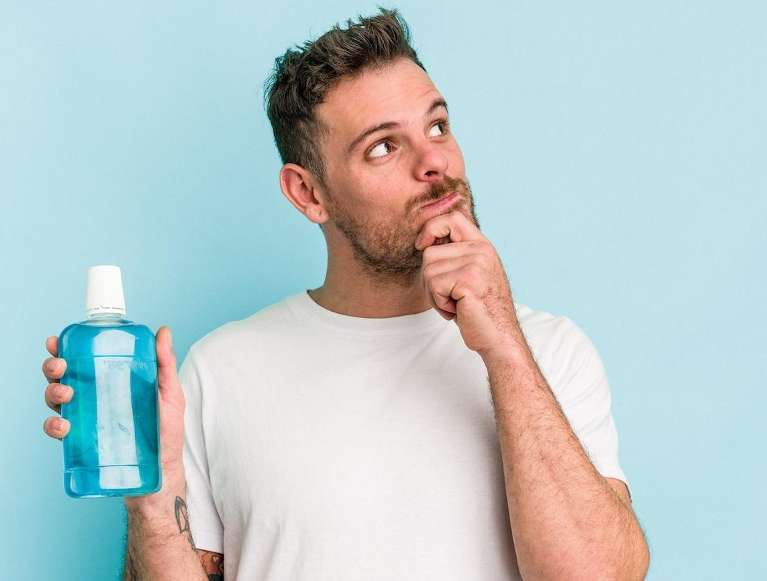
Brushing your teeth twice a day and flossing once a day are the cornerstones of good oral hygiene. But what about mouthwash? Many people wonder if there’s a strategic time to incorporate it into their routine. Should you use mouthwash before brushing, or is there a better order of operations? This blog dives deep into the world of mouthwash and brushing, exploring the pros and cons of each sequence and offering guidance on maximizing your oral health.
The Power of Brushing:
Brushing is the workhorse of oral hygiene. A good brushing technique physically removes plaque, the sticky film that harbors bacteria and contributes to cavities and gum disease. Your dentist will be happy to demonstrate proper brushing technique, but here’s a quick refresher:
- Use a soft-bristled toothbrush and fluoride toothpaste.
- Brush for two minutes, twice a day, reaching all surfaces of your teeth, including the tongue.
- Use gentle, circular motions.
The Benefits of Mouthwash:
Mouthwash isn’t a replacement for brushing, but it can be a valuable addition to your oral care routine. Here’s how mouthwash can benefit your smile:
Freshens breath:
Mouthwash contains ingredients that kill bacteria that cause bad breath.
Reduces plaque and gingivitis:
Some mouthwashes contain ingredients that help reduce plaque buildup and fight gingivitis, the early stage of gum disease.
Remineralizes teeth:
Mouthwashes that contain fluoride can help strengthen tooth enamel and stave against cavities.
Provides additional cleansing:
Mouthwash can reach areas that your toothbrush might miss, like between teeth.
Mouthwash Before Brushing: Pros and Cons
There are some potential benefits to using mouthwash before brushing:
- Loosens plaque: The antiseptic agents in mouthwash may help loosen plaque, making it easier to remove with brushing.
- Reduces bacteria: Rinsing with mouthwash before brushing can reduce the overall level of bacteria in your mouth.
However, there are also some drawbacks:
Washes away toothpaste: Mouthwash can rinse away some of the beneficial fluoride left behind by toothpaste. Fluoride strengthens teeth and prevents cavities, so this can be counterproductive.
May mask underlying issues: If you consistently experience bad breath after rinsing with mouthwash before brushing, it could be a sign of an underlying oral health issue that needs to be addressed by a dentist.
Mouthwash After Brushing: Pros and Cons
Using mouthwash after brushing offers some advantages:
- Preserves fluoride: Since you’ve already brushed, the fluoride from your toothpaste has had a chance to work its magic. Rinsing with mouthwash won’t wash it away.
- Reaches missed areas: Mouthwash can help cleanse areas that your toothbrush might have missed, leaving your mouth feeling even fresher.
There are few downsides to using mouthwash after brushing:
- May not be as effective at removing plaque: Since you’ve already brushed, the mouthwash may not be as effective at loosening and removing plaque.
The Verdict: Brushing First is Generally Preferred
While both methods have their merits, most dentists recommend using mouthwash after brushing. This allows the fluoride from your toothpaste to do its job and ensures you’re not rinsing away any beneficial effects.
Here’s the recommended oral hygiene routine:
- Brush your teeth for two minutes with fluoride toothpaste.
- To get food particles and plaque out from in between your teeth, floss.
- Rinse with mouthwash (optional, but recommended after brushing).
Additional Tips for a Sparkling Smile:
Choose the right mouthwash:
Look for a mouthwash that contains fluoride and is alcohol-free. Alcohol can dry out your mouth, which can contribute to bad breath.
Don’t swallow mouthwash:
Mouthwash is not meant to be ingested.
Schedule regular dental checkups:
At least twice a year, schedule expert cleanings and examinations at your dentist.
Maintain a healthy diet:
Limiting sugary foods and drinks can help reduce your risk of cavities.
- Remember: Consistency is key! Following a consistent oral hygiene routine that includes brushing, flossing, and using mouthwash (after brushing) is the best way to maintain a healthy smile.
Beyond Brushing and Mouthwash: Optimizing Your Oral Care Routine
Brushing and mouthwash are foundational for a healthy smile, but there’s more you can do to elevate your oral hygiene game. Here are some additional tips:
Don’t Neglect Your Tongue:
The tongue harbors bacteria that can contribute to bad breath. Use a gentle tongue scraper or brush your tongue with your toothbrush to remove bacteria and debris.
Consider Antiseptic Mouth Sprays:
While not a replacement for mouthwash, antiseptic mouth sprays can offer a quick burst of freshness throughout the day, particularly after meals or coffee breaks.
Stay Hydrated:
Drinking plenty of water helps to flush away food particles and bacteria in your mouth. The target is eight glasses of water every day.
Kick the Bad Habits:
Smoking and excessive use of alcohol can contribute to gum disease and other oral health problems. Talk to your doctor or dentist if you need help quitting smoking.
Power Up with Vitamins:
Ensure you’re getting enough essential vitamins and minerals, especially vitamin C, vitamin D, and calcium, which are all important for oral health.
Considering the sequence of mouthwash before brushing can enhance your oral hygiene routine, enabling you to make informed choices for better oral health. Consistency remains crucial! Regular brushing, flossing, and employing mouthwash (preceding brushing) form the pillars of a healthy smile. For tailored guidance and addressing specific concerns, consulting with your dentist is paramount.